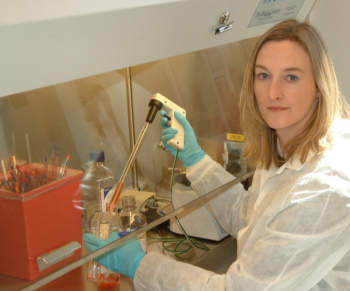The Challenge of Drug-Resistant HIV
by Jeffrey Laurence, M.D.
May 30, 2006—Dr. Jacqueline Reeves, working as an amfAR-funded fellow at the University of Pennsylvania, has published a study in this month’s journal Virology with potentially important implications for patients with drug-resistant HIV.

Jacqueline Reeves, Ph.D.
|
Worldwide, an increasing proportion of HIV-positive people on drug therapy harbor drug-resistant virus. This prompted an editorial in the British Medical Journal warning that “a substantial portion of these patients seem to be in danger of exhausting their options for antiretroviral treatment.” The situation bears close scrutiny, particularly in the U.S.
Only about one-third of Americans on highly active antiretroviral therapy (HAART) are able to suppress their viral loads to undetectable levels—viral concentrations associated with long-term clinical benefits—for more than 18 months. Another third will have virus resistant to two anti-HIV drug classes. One in eight shows resistance to three of the four approved classes of anti-HIV drugs.
The coupling of these increases in drug-resistant virus with greater sexual risk-taking among adolescents and adults compounds the situation. We need to increase prevention education, of course, and study novel ways to encourage maintenance of those protective behaviors. But we also need new classes of anti-HIV drugs, ones that are effective against drug-resistant HIV strains, and perhaps less vulnerable to HIV's ability to change rapidly. This is where Dr. Reeves’s work becomes relevant.
In order to infect a person, HIV must enter cells. In order to do that, it needs to bind to two proteins on a cell’s surface: CD4 and a co-receptor, usually either CXCR4 or CCR5. Given that CCR5 is required for infection by almost all strains of HIV, anti-CCR5 agents are being developed and tested both as part of HAART and by themselves as potential microbicides. (A microbicide—a product that does not yet exist—might take the form of a foam, cream, or gel that could be applied to the surface of the vagina or rectum to block sexual transmission of HIV.)
Dr. Reeves’s amfAR-funded work explores mutations in CCR5 and other co-receptors that HIV could use to enter cells. She studied how co-receptor binds to the outer envelope of HIV, known as gp120, causing a change in HIV’s inner envelope—a critical first step in the infection of a cell. She hypothesized that these changes are easier to trigger in some AIDS virus envelopes than others. Dr. Reeves went on to produce mutations in AIDS virus envelopes that affected how efficiently the co-receptor bound to the envelope. This, in turn, increased the susceptibility of the mutated viruses to drugs targeting the HIV co-receptor.
Dr. Reeves concluded that “our results and previous studies indicate that the bridging sheet region of gp120 comprises a universal co-receptor-binding site that is important for efficient utilization of both major and minor co-receptors.”
Identification of such universal targets is the type of progress needed to jump-start new strategies for HIV drug and microbicide development.
Dr. Laurence is senior scientific consultant for programs at amfAR.